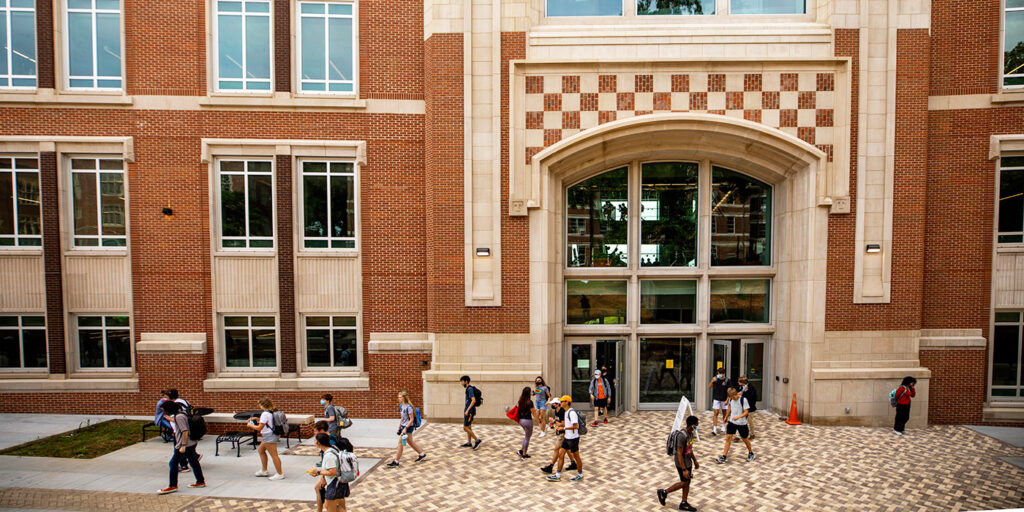Article authored by Meghan McDonald.
Last summer, an interdisciplinary team from the College of Arts and Sciences and the Tickle College of Engineering saw their hard work rewarded: the University of Tennessee earned a Materials Research Science and Engineering Center (MRSEC) from the National Science Foundation. “The unique MRSEC model is a nexus for new science and new opportunities,” says UT’s MRSEC director, Professor of Physics and Materials Science Alan Tennant. “Going forward, we’re leveraging that model to transform the paradigm for researching next-generation quantum materials and materials for extreme environments.”
The research at UT’s MRSEC — called the Center for Advanced Materials and Manufacturing (CAMM) — has implications for mobility, national security, aerospace, computing, carbon-free energy, and other key fields. “The MRSEC model synergistically brings all these different facets together through interdisciplinary research groups (IRGs),” Tennant says. At CAMM, IRG1 is led by Physics and Astronomy Department Head Adrian Del Maestro and brings together physics, chemistry, materials science, electrical engineering, and computer science to study quantum materials. IRG2, led by Governor’s Chair for Nuclear Materials and Professor Steven Zinkle, adds civil, environmental, and nuclear engineering to the mix to study and develop materials for extreme conditions, including temperature, pressure, and radiation.
“The driving force behind both IRGs is artificial intelligence (AI),” says Del Maestro. “We have too much data across too many axes to understand. So we’re using AI to identify grand unifying patterns to predict underlying material qualities and determine guiding principles of material behavior.”
Yishu Wang, IRG1 member and assistant professor of materials science and physics, uses neutron scattering in her search for quantum materials that outperform silicon-based technologies for computation and information processing. “Traditionally, this has been time-consuming,” she says. “AI-controlled experimental parameters can streamline the process.” Machine learning models, she explains, can analyze neutron scattering patterns in real time and recognize subtle similarities and differences.
“There are millions of unknown material compositions,” Zinkle says. “In the past, selecting parameters for experiments felt like throwing darts. AI and machine learning help us be smart in selecting compositions and conditions to try.” For IRG2, this will accelerate finding materials suitable for extremes, like those needed for hypersonic aircraft and next-generation nuclear energy production. It will also open a new avenue for discovery: predicting how extreme conditions can be used to create completely new types of materials. “I’m optimistic we could see a suite of new high-performance alloys emerge over the next six years,” Zinkle says.
In contrast to the traditional academic model of a single investigator or faculty advisor to a group of students, CAMM immerses each faculty member, post-doctoral researcher, and student in an IRG. Students have multiple advisors and direct access to a large team with shared goals yet highly varied expertise. “Students will gain familiarity with AI and learn how to solve problems by fusing knowledge from different disciplines,’” Del Maestro says.
Industry advisors and partners, including Tennessee-headquartered Eastman, will also bring their real-world problems to CAMM. “Their input will help us go in the right research directions,” Zinkle says, “and industry perspectives will help prepare students to tackle almost anything in their future jobs.”
Del Maestro believes CAMM’s combination of AI-accelerated research, interdisciplinary approach, and diverse partnerships can also lead to faster technology transfer. He notes that some of today’s common technologies took nearly 100 years to journey from basic understanding to commercial application. With so many real-world implications at stake, next-generation materials need a shorter timeline.
“We’ll also make our machine learning models public on an open-source database,” Del Maestro says. “Other researchers can send information on their new materials, and the database will predict if they’re on the right track. This could have an impact far beyond us.”
“The University of Tennessee has invested in an interdisciplinary approach over the long term,” Del Maestro sums up. “That enabled us to achieve the MRSEC, and going forward, it will enable us to be successful — to lay foundations for discovery that will keep driving innovation.”
Contact
Melissa Callahan (865-974-9387, engrcomm@utk.edu)
